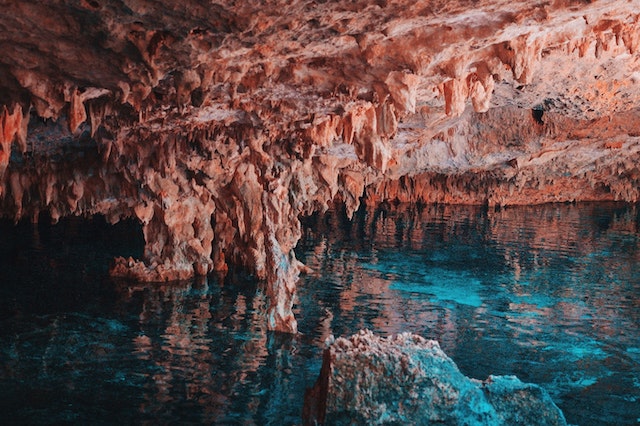
What are stalagmites and stalactites? They are deposits of minerals that form in caves. Stalactites hang down from the top of the cave and stalagmites rise up from the ground. To help you remember, stalactites have a “c” for ceiling and stalagmites have a “g” for ground. If you want another way to remember which is which then the word “stalactite” comes from the Greek word “stalassein”, which means “to drip”. “Stalagmite” also comes from Greek and means “dropping” or “trickling”. Stalactites are formed by dripping water and stalagmites are formed by dropping water.
All stalactites and stalagmites are speleothems, which are cave formed minerals. There are different types of stalactites and stalagmites but the most common ones are made of calcium carbonate. Not all caves have stalactites and stalagmites because they require a certain set of conditions. The cave needs to be made of limestone to begin with. It also needs to have a lot of dead organic matter in the soil above it and it needs to be in an area that has regular rainfall. When it rains, the water enters the soil and picks up carbon dioxide from the decomposing organic matter. This carbon dioxide rich water soaks through the soil and enters the limestone through cracks and fissures. As it goes through, a mineral called calcite is dissolved from the limestone into the water by the carbon dioxide. When calcite comes into contact with carbon dioxide it dissolves. When the rainwater reaches the bottom of the limestone it enters the cave and it loses the carbon dioxide it had absorbed into the cave air. The carbon dioxide was the only thing keeping the calcite dissolved in the water and once it has gone, the calcite solidifies and gets deposited on the ceiling of the cave. The water will then drip off. If the water that drips off still contains some calcite, this will be deposited on the floor of the cave, forming a stalagmite. This is why stalactites and stalagmites are usually opposite each other.
So, why do stalactites and stalagmites grow? The water doesn’t release the calcite it is holding until it comes into contact with the air of the cave. As the stalactite builds up, the water travels through the limestone, into the stalactite, and all the way down to the tip of it before it releases its calcite. And the opposite happens for the stalagmite. They also grow extremely slowly because they can only grow at the speed with which the water drips through the cave roof. That is why greater rainfall and more decomposing matter in the soil can increase the speed they grow at. Some of the largest stalactites and stalagmites are hundreds of thousands of years, possibly even millions of years old. They can also be a variety of colors depending on what other compounds the water carries with it. Iron, for example, will make them red or orange.
If there is enough water and they are left for long enough, stalactites and stalagmites can join in the middle. When that happens, they form a column. There are several different types of stalactites and stalagmites as well. Most of them are solid with a wide base tapering to a narrow point, but there are also straw-shaped ones. They are formed when water runs down the inside of the tube and evaporates, releasing the calcite. They are not very strong and crumble away easily. There are also some stalactites called helictites, which comes from the Greek word “heliktos”, meaning “twisted”. They begin in the same way as regular stalactites but then they start to twist and can even become horizontal. Some of them change direction more than once and can resemble a collection of worms, or fingers. Nobody knows for sure what causes them, but it is probably partly to do with the wind in the cave. Stalactites form vertically because of gravity. If the wind in the cave is strong enough to overcome gravity, then the water will flow sideways and deposit the calcite as it goes.
There are also flowstones and cave popcorn. Flowstones are formed when water comes through the roof of the cave and flows down the cave wall in a sheet rather than dripping from the roof. When this happens, it deposits the calcite all over the cave wall. They look like a frozen waterfall. Cave popcorn is formed when the water drips through hundreds of pores in the cave roof rather than just dripping through in one place. And this is what I learned today.
Photo by Viviana Camacho: https://www.pexels.com/photo/water-under-caved-2432208/
Sources
https://www.livescience.com/stalagmites-and-stalactites
https://www.nps.gov/ozar/learn/education/speleothems.htm
https://oceanexplorer.noaa.gov/facts/stalactite.html
https://en.wikipedia.org/wiki/Stalactite
https://en.wikipedia.org/wiki/Stalagmite
https://www.nps.gov/grba/learn/nature/speleothems-cave-formations.htm
https://uh.edu/~jbutler/kunming/carbonates.html
https://www.nps.gov/maca/learn/nature/stalactites-stalagmites-and-cave-formations.htm
https://en.wikipedia.org/wiki/Helictite
